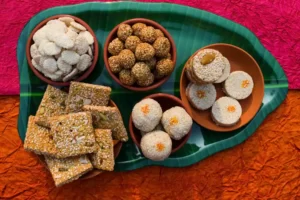Last Updated on 10 months by hejalbood
Makar Sankranti is a festival which is celebrated all over the country with different names and customs. also known as Pongal in Tamil Nadu, Lohri in Punjab, and Uttarayan in Gujarat, is a joyous Hindu festival celebrated across India every year on January 14 (or 15th in some regions). It marks the transition of the sun from Sagittarius (Dhanu) to Capricorn (Makar). This astronomical event signals the end of the winter solstice and the beginning of longer, warmer days.
Here are some key aspects of Makar Sankranti:
Spiritual Significance

Hindus worship Lord Surya on this day, taking a holy dip in rivers like the Ganga and Yamuna. It is believed that a cleansing bath washes away sins and brings true success.
Harvest Festival

Makar Sankranti coincides with the harvest season in many parts of India. Farmers express gratitude for the bountiful harvest and celebrate the prosperity it brings.
Festive Dishes

Sweet dishes made from sesame seeds and jaggery are a main part of Makar Sankranti celebrations. These elements symbolise warm temperatures, power, and wonder. Other dishes from nearby, such as pongal (rice dish) in Tamil Nadu and sugarcane in North India, are also enjoyed.
Kites and Bonfires

Colourful kites cover the entire sky during Makar Sankranti, especially in Gujarat and Rajasthan. In some areas, bonfires are also lit to symbolise the burning of negativity.
Family Gathering

Makar Sankranti is a time for families to come back together, eat food in equal proportions, exchange gifts, and enjoy each other’s company. It’s a joyous event with laughter, music, and dance.
Why Makar Sankranti is celebrated
In the Vedas, Sankranti describes the movement of the Sun from one zodiac sign to another. In fact, there are twelve Sankrantis in a year. The most auspicious of these, Makar Sankranti, also known as “Pausha Sankranti”, is related to the solar cycle. The importance of Makar Sankranti is not only for religious reasons. In fact, this festival also marks the beginning of the harvest season, when new crops are worshipped and joyfully shared.
This day marks the official end of winter, as the Sun begins its movement from the Dakshinayan (South) to the Uttarayan (North) hemisphere, marking the beginning of the change in seasons. This occasion is the seasonal ritual and religious occasion of the entry of Capricorn (Sun).
Makar Sankranti When
Makar Sankranti is usually celebrated on January 14 every year, but in leap years, it falls on January 15. Since 2023 is not a leap year, Lincoln 2024 is a leap year, so this time Makar Sankranti will be celebrated on Sunday, January 14.
Method of bore bath
To take bore bath, first fill water in a big vessel. Then add bor, sesame, fruits, flowers, and other ingredients to it. Now take bath with this water. While taking bath, salute the Sun God and seek his blessings.
Benefits of Bore Bath
There are many benefits of bore bath. This bath purifies the body and protects from diseases. This bath provides mental peace and happiness. This bath increases wealth and prosperity.
Bored Bath Time
The best time to take a bore bath is in the morning. It is customary to offer Arghya to the morning sun on Makar Sankranti day and then take a bore bath.

